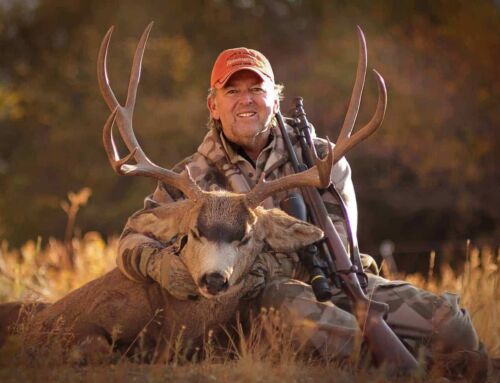This buck’s rack is coming along nicely. Did you know and those antlers will grow another 1/8- to ¼-inch per day for the next 2 months?
Here are more interesting facts about the whitetail’s summer antlers:
—Antlers are made of bone, consisting mostly of calcium, phosphorus, magnesium and other minerals. Although some of the minerals needed for antler growth are taken from food, scientists note that lot of them are sucked from the buck’s skeleton, which may cause him to develop osteoporosis during the summer. Setting mineral licks for the deer can help.
–Throughout June and July, velvet antlers grow via a complex system of blood vessels, which causes them to be hot to the touch. Top whitetail scientist Dr. Grant Woods notes, “There is so much blood carrying protein and minerals to a buck’s antlers this time of year that even small antlers are easily detected by thermal imaging devices. Antler tines show up like neon signs when flying over with thermal cameras in summer.”
–Tiny hairs on the velvet stick out and make the antlers look bigger than they are. The hairs act as a radar system so the buck won’t bump into trees, fence posts, etc. and damage his soft antlers.
–Sebum, a semi-liquid secretion, on the hairs gives the velvet a shiny look. Sebum acts as an insect repellent to keep biting flies off a buck’s rack and face.
—In early August antlers begin to change from soft and pliable to hardened bone. “A buck’s antlers will change from looking swollen or bulbous at the tips of the tines to a more normal diameter,” notes Dr. Woods. “Once this change in appearance occurs the buck won’t add much beam or tine growth.”
—By mid-August most of the antler growth for the year is done.
–Sometime between September 1 and 20 bucks shed the velvet. The cue for antler hardening and velvet shedding is the change in photo-period caused by decreasing daylight and increasing darkness, which results in a significant increase in the bucks’ testosterone.
–With many bucks the process of velvet shedding takes only a couple of hours, though it is not uncommon to see a deer walking around for day or two with bloody velvet tatters. One last thing you might not know, bucks have been known to turn their heads and peel or even eat the dry velvet off their new racks.







Great info Mike! Here in Arizona since our coues don’t drop their antlers until late May and even June their antlers are still growing through the end of September and you’ll find some bucks still in velvet all the way through October! It’s cool and we get a great shot at killing velvet bucks due to our 2 week August Archery season!